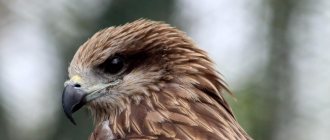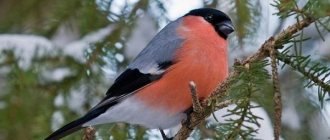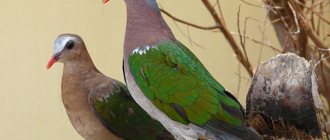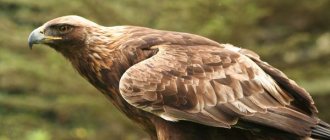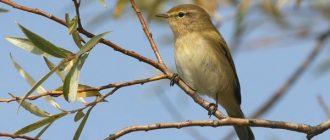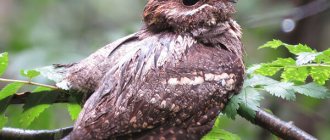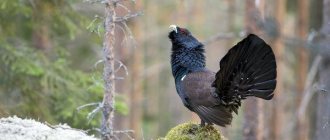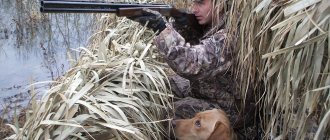| Latin name: | Jynx torquilla |
| English name: | To be confirmed |
| Kingdom: | Animals |
| Type: | Chordata |
| Class: | Birds |
| Squad: | Woodpeckers |
| Family: | Woodpeckers |
| Genus: | Verticheyki |
| Body length: | 17-20 cm |
| Wing length: | To be confirmed |
| Wingspan: | 25-30 cm |
| Weight: | 32-48 g |
Description of the bird
The body length of the wryneck is from 17 to 20 cm, the wingspan is from 25 to 30 cm, the weight is in the range of 32-48 g. The plumage of the male and female is the same, made in camouflage colors, which allows the birds to remain invisible among the trees. The back is mottled, grayish-brown with dark longitudinal streaks, which sometimes form a large spot. The belly is whitish with a transverse pattern. There is a clear dark stripe from the corner of the beak through the eyes and along the neck, and another one runs through the crown and back of the head. The neck and breast area have a yellowish or buffy color. The iris is dark brown, the beak and paws are dull and brownish. Juveniles resemble adults, but the patterns on their plumage are blurred.
— Advertising —
The tail of the whirligig is rounded and consists of soft feathers, so it cannot, like other woodpeckers, serve as a support for the bird on vertical tree trunks. Therefore, birds obtain their food while sitting on branches or directly from the ground. The beak is short and sharp. Whirlwinds do not dig into wood, but they can get food from under the rotting bark.
Whirlwind: why was this bird called that?
It must be said that this bird is rather lazy, clumsy and moves only when absolutely necessary. She completely lacks the agility and tirelessness of her relatives, the woodpeckers, and other flying birds, but at the same time she has a name that is more suitable for a nimble individual - the whirligig, why is that?
The bird was named the same in almost all languages for its amazing ability to turn its head. Anything that frightens or irritates a bird makes it make amazing faces, and the more frightened it is, the more strange the poses it takes. The whirligig can stretch its neck forward, ruffling its feathers and spreading its tail like a fan, or stretch forward with its entire body, bend over and, closing its eyes, emit a dull grunt.
If you look into the hollow where the female is hatching her eggs, she will open her beak and begin to hiss loudly, bending her neck like a snake. Dark feathers moving on the back support the illusion of an angry amphibian.
By the way, caught spinners are one of the most entertaining birds that can be kept in captivity.
What does it eat?
During the nesting period, the diet of the whirligig consists mainly of small ants, for example, turf, yellow earth, red wood ants, as well as various species of lasius and formica. Mostly the whirligig eats not adults, but larvae and pupae. In addition, the bird also feeds on other insects: aphids, caterpillars and beetles, as well as plant foods, berries and fruits.
Interestingly, when searching for food, whirligigs pay attention to bright objects, which is why pieces of foil, bright plastic, and small metal objects are often found in the stomachs of birds.
Spintail in the Red Book
The wryneck is listed in the Red Book of Moscow. It has been assigned a conservation status: category 3 – a vulnerable species in the city.
The individual is considered widespread, but small in number. Nesting was recorded in Losiny Ostrov, the valley of the Setun River. The absence of birds in the Izmailovsky and Bitsevsky forests is associated with the disappearance of ants.
In the period from 2001 to 2010. 20 new nesting sites were identified within the city.
To preserve the species, it is important to support the following activities:
- creation of specially protected natural areas in potential nesting areas;
- ensuring the preservation of broom trees near rivers in proper condition;
- restoration of vegetation in landscaped valleys.
At the moment, a program is being implemented to restore ants in large forests, preserve hollow trees, and regularly hang artificial nests.
The general population of the species is not threatened today.
Spreading
— Advertising —
In Africa, the wryneck is common in Algeria and Tunisia, as well as on the Mediterranean coast. In Eurasia, the bird is found in a vast forest area, starting from the east of the Iberian Peninsula and the west of France and east to Kolyma, Sakhalin, the Kuril and Japanese Islands.
The woodpecker is the only migratory species of woodpeckers that lives in Europe. Only certain African populations of this bird lead a sedentary lifestyle. From the Mediterranean coast and the mountains of Central Asia, whirligigs migrate short distances. The remaining populations fly far away. Thus, wintering grounds of this species are found south of the Sahara, in Senegal, Gambia and Sierra Leone, in Ethiopia, Congo and Cameroon. Wraithnecks, which live in Siberia and the Far East, fly to India and Southeast Asia for the winter.
During the nesting period, whirligigs prefer sparse deciduous or mixed forests, in which aspen, linden or birch grow. The bird builds nests in forest clearings, clearings, edges, forest belts and coastal thickets. In addition, the whirligig is not at all afraid of people and is often found in cultivated landscapes, gardens and parks. The bird avoids only open steppes.
Who is the whirligig “at war” with?
Since the whirligig itself is a small bird, anyone who is bigger and stronger can encroach on it. The bird has no specific enemies, but everyone who loves bird eggs and meat is a potential enemy.
Even relatives can offend this bird. Most often, aggression comes from pileated woodpeckers, who like to drive whirligigs out of their place of residence. Among the worst enemies are such feathered predators as: hawk, falcon, kite, etc.
There is no escape from terrestrial predators for whirligigs. A marten can look into their hollow at any moment. The ermine and sable will not be left out either. Their favorite pastime is destroying nests. Squirrels, along with nuts, also love to eat bird eggs. They can even kill hatched chicks.
Parasites are also worth mentioning. As a migratory species, the wryneck is an easy target for parasites such as fleas, ticks and lice beetles. This scourge penetrates through adult individuals into the nesting site, where it waits for the brood to hatch and then spread to it.
Even the weather can threaten the chicks. Low temperatures, rain and strong winds prevent the chicks from leaving the nest and learning to fly. The longer the chicks are forced to stay in the hollow, the higher their chance of being eaten.
Humans are also involved in the reduction of the type of vertigo, although not directly. People simply destroy their habitats: rotten trees, from which the forest is cleared; cutting down groves and more. Often, to treat diseased trees, pesticides are used, which completely deprive the spiny worms of their usual food.
Interesting for ornithologists to observe is the relationship between the great tit and the whirligig. Tits often destroy the nests of whirligigs, eating their chicks, and thereby take up space. Wingtails do the same with tits. They have a larger body on their side, while great tits are more aggressive and differ in speed.
Kinds
The genus of the wryneck includes two species, one of which is distributed in the forest zone of Eurasia, and the second lives in Africa south of the Sahara:
Common whirligig (Jynx torquilla)
The whirlwind, or common whirlwind (Jynx torquilla) is a resident of Eurasia;
Red-throated Wrangler (Jynx ruficollis)
The red-throated wryneck (Jynx ruficollis) lives in Africa.
The plumage of both species is the same, consisting of protective gray-brown tones. The common whirligig has a yellowish neck and breast, while the red-necked one has a reddish tint.
Nutrition
This bird is happy to be kept at home, in a cage. Therefore, many people ask the question - what does the whirligig eat ? In nature, they mainly feed on protein foods, preferring ants. For this feature in Spain, birds are often called anteaters.
They gladly destroy their larvae and the ants themselves, but a special delicacy for them is the pupae and eggs of these insects. Birds also feed their offspring with them. In addition, they feed on caterpillars, aphids, and bugs. They can eat berries or peck ripe fruit.
Actually, this is what birds are fed in captivity. Feed mixtures consisting of dried ant eggs, larvae and dried insects can be found in pet stores. It should be mentioned here that it is advisable to clean the cage more often.
Birds love to scatter garbage and also look for and peck at bright and shiny objects. In addition to pieces of paper, foil, and polyethylene, you may also find more dangerous things - sharp metal or plastic objects.
Reproduction
Each season the wryneck forms a new pair. These birds return from their wintering grounds late, in the second half of April or early May.
The bird nests in the voids of old trees, rotten branches, rotten stumps, or occupies a ready-made hollow at a height of up to 3 m from the ground. Due to its weak beak, the whirligig cannot hollow out a hollow on its own. Sometimes birds occupy holes in the walls of barns or country houses, as well as birdhouses. If all the places suitable for nesting are occupied, the whirligig may well drive the owners out of the hollow it likes. Redstarts and gray flycatchers often suffer from this bird behavior. At the same time, Great Spotted or Syrian Woodpeckers can attack the whirligig itself in the same way.
The male chooses the nesting site. Having found a suitable hollow, he screams loudly and for a long time, calling for the female. The female responds with a similar cry, after which the birds approach and mate. The discovered nest of the whirligig is not arranged in any way. The litter is wood dust or remains from the nest of previous inhabitants.
The female lays one or two clutches of eggs per season in late May - early June. In one clutch there are on average 7-10, sometimes up to 14 eggs. The eggs are light, almost white. When a clutch is lost, the female makes a new one. Eggs are laid at intervals of 1 day, incubation begins from the penultimate one and lasts about 2 weeks. The female does the incubation; occasionally she can be replaced by a male.
The chicks are born asynchronously, and sit in a hollow in a pyramid with their beaks towards the center. Both partners feed them; they take turns bringing food in the form of balls in their crops, which they regurgitate into the chick’s beak.
The chicks fledge at the age of 23 to 27 days, after which the brood disintegrates.
How a whirligig arranges its home
The bird in question most readily settles on the outskirts of clearings, forest edges and small clearings in mixed or deciduous forests, where a large number of lindens, aspens and birches grow. The whirlwind is not afraid of people, willingly settling nearby. It can live, for example, in a hole in the wall of a barn or an old country house.
Like all woodpeckers, this nimble bird loves hollows, as well as horizontal passages in rotten branches or other voids. It is also suitable for birdhouses and even burrows of bee-eaters and mints, if there are trees or bushes nearby.
She does not lay out litter in the hollow, leaving only pieces of wood there.
Sometimes the whirligig bird can hollow out a hollow for itself (usually it does this in the soft wood of aspen trees), but most often it takes what it likes with a fight. The brave flycatcher can drive a tit, a nuthatch, and a flycatcher out of their hollows and throw out nests, even with ready-made clutches, in order to lay from 6 to 10 matte white round eggs, which appear pinkish from the translucent whites.
By the way, from the remains of nests and eggshells scattered on the ground, you can find the tree where the whirligig has settled.
Voice
Wingtails sing during the mating season, their voice at this time resembles the song of a green, gray or black woodpecker. Singing consists of 12-18 monotonous drawn-out sounds “ti-ti-ti-ti”, which are repeated at a speed of up to 4 times per second. The male starts screaming first, thus attracting the female. When the female responds and the birds approach each other, a pair is formed. If there is no female nearby, the male flies to a new hollow and starts his song all over again. When paired, whirligigs do not sing.
The alarm signal in birds sounds like a quiet “tek-tek” or “piz-piz.” A disturbed whirligig makes hissing sounds.
Features of character and lifestyle
Photo: Whirling neck in nature
During migrations and wintering, whirligigs can gather in small flocks of 10–12 birds, but in summer they always separate into pairs. Each pair “clogs” its territory, maintaining a distance between nests of at least 150 - 250 m. Only in extreme cases do they settle closer to each other. They remain secretive and do not advertise their presence.
Most of the time, birds feed by climbing branches and tree trunks and continuously collecting ants and other small items on and under the bark. Very often they descend to the ground, where they move in short leaps and balance with their outstretched tail. Continuously snatching insects from grass and litter, they do not lose their vigilance, constantly monitoring the surroundings. The flight of the whirligigs is slow and uneven, but they can somehow catch flying insects.
A bird sitting on a tree takes a characteristic pose with its head held high and its beak raised. Perhaps this is how she imitates a knot. When two individuals, but not spouses, meet, they perform a peculiar ritual: they throw back their raised heads, open their beaks and shake their heads, sometimes dropping them to the side. Nobody knows what this means.
The most original feature of whirligigs is their behavior in case of danger. A bird, disturbed on the nest or caught, lowers its wings, spreads its tail, stretches its neck and rotates it like a snake, sometimes throwing its head back, sometimes turning it from side to side. The feathers on the head stand on end. At the same time, it hisses like a snake and all this, coupled with the effect of surprise, creates the complete impression of an attacking reptile. In extreme cases, the bird feigns death and hangs in the hands of the catcher with its eyes closed.
Spring arrival occurs unnoticed, often at night. In the southern regions of Russia they arrive in the first half of April, in the north - in the first half or even at the end of May (Yakutia). They also fly away unnoticed in the fall, starting from the end of August, sometimes even in November (Kaliningrad).
Interesting Facts
- The ancient Greeks attached magical significance to the pinwheel. The bird was considered Iinga, the daughter of Pan, who was punished by Hera for helping in the connection between Zeus and Io.
- The whirligig got its name because of its characteristic behavior in stressful situations. If a bird is suddenly picked up or taken by surprise, it straightens its tail, ruffles its feathers, hangs its wings, and rushes at the offender, rotating its neck and eyes. At the same time, the bird hisses like a snake and gurgles. That is why, if you stick your hand into a hollow with a spinner, it seems that there is a snake there, not a bird.
- Until the mid-20th century, up to 200-400 pairs of the wryneck nested in Great Britain, but now it is rare on the island. In recent decades, the population of these birds has also begun to decline in various European countries, for example, in Scandinavia, Germany, Denmark and Switzerland. A possible reason is deforestation and a decrease in areas suitable for bird habitat.
What does a whirligig look like?
Despite the very recognizable appearance of the whirligig, it is easier to confuse it with representatives of passerines than with representatives of woodpeckers. A small bird, usually 20 centimeters long and weighing up to 50 grams.
Adorable little one! Bright, motley, gray-brown upperparts, with long streaks on the back, forming one spot on the back, a white belly with patterns characteristic of all small birds - wavy.
Jynx torquilla (lat. Jynx torquilla)
A clearly visible black stripe runs through the back of the head, as well as from the beak through the eye. The throat and chest sometimes have a yellowish tint. Young chicks are similar to adults, only their patterns are less bright and clear. On the feet, two toes point forward and two point back. Females and males decided to properly camouflage themselves from danger: their appearance is very similar to tree bark. And these birds also have a long and sticky tongue. If someone decides to scare or offend a bird, they will immediately take defense: they will spread their tail and wings, ruffle their feathers, begin to roll their eyes and neck, making hissing sounds.
A whirligig with spread wings and tail.
If you stick your hand into a hollow and disturb the whirligig, its invisible but audible actions will resemble the hiss of a snake, and not the chirping of a bird.


